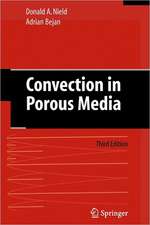Porous and Complex Flow Structures in Modern Technologies
Autor Adrian Bejan, Ibrahim Dincer, Sylvie Lorente, Antonio Miguel, Heitor Reisen Limba Engleză Hardback – 29 apr 2004
Similarly, the demands of miniaturization in electronics and in biomedical applications are driving research into the flow of heat and fluids through small-scale porous media (heat exchangers, filters, gas exchangers). Filters, catalytic converters, the drying of stored grains, and a myriad of other applications involve flows through porous media.
By providing a unified theoretical framework that includes not only the traditional homogeneous and isotropic media but also models in which the assumptions of representative elemental volumes or global thermal equilibrium fail, the book provides practicing engineers the tools they need to analyze complex situations that arise in practice. This volume includes examples, solved problems and an extensive glossary of symbols.
| Toate formatele și edițiile | Preț | Express |
|---|---|---|
| Paperback (1) | 702.54 lei 6-8 săpt. | |
| Springer – 12 dec 2011 | 702.54 lei 6-8 săpt. | |
| Hardback (1) | 952.89 lei 6-8 săpt. | |
| Springer – 29 apr 2004 | 952.89 lei 6-8 săpt. |
Preț: 952.89 lei
Preț vechi: 1162.06 lei
-18% Nou
Puncte Express: 1429
Preț estimativ în valută:
182.33€ • 190.88$ • 150.87£
182.33€ • 190.88$ • 150.87£
Carte tipărită la comandă
Livrare economică 05-19 aprilie
Preluare comenzi: 021 569.72.76
Specificații
ISBN-13: 9780387202259
ISBN-10: 0387202250
Pagini: 396
Ilustrații: XII, 396 p. 49 illus.
Dimensiuni: 155 x 235 x 23 mm
Greutate: 0.66 kg
Ediția:2004
Editura: Springer
Colecția Springer
Locul publicării:New York, NY, United States
ISBN-10: 0387202250
Pagini: 396
Ilustrații: XII, 396 p. 49 illus.
Dimensiuni: 155 x 235 x 23 mm
Greutate: 0.66 kg
Ediția:2004
Editura: Springer
Colecția Springer
Locul publicării:New York, NY, United States
Public țintă
ResearchCuprins
1 Porous Media Fundamentals.- 2 Flows in Porous Media.- 3 Energy Engineering.- 4 Environmental and Civil Engineering.- 5 Compact Heat Transfer Flow Structures.- 6 Living Structures.- 7 Drying of Porous Materials.- 8 Multidisciplinary Applications.- Nomenclature.- References.
Textul de pe ultima copertă
Porous and Complex Flow Structures in Modern Technologies represents a new approach to the field, considering the fundamentals of porous media in terms of the key roles played by these materials in modern technology. Intended as a text for advanced undergraduates and as a reference for practicing engineers, the book uses the physics of flows in porous materials to tie together a wide variety of important issues from such fields as biomedical engineering, energy conversion, civil engineering, electronics, chemical engineering, and environmental engineering.
For example, flows through porous ground play a central role in energy exploration and recovery (oil, geothermal fluids), energy conversion (effluents from refineries and power plants), and environmental engineering (leachates from waste repositories). Similarly, the demands of miniaturization in electronics and in biomedical applications are driving research into the flow of heat and fluids through small-scale porous media (heat exchangers, filters, gas exchangers). Filters, catalytic converters, the drying of stored grains, and a myriad of other applications involve flows through porous media.
Another new feature is the ‘constructal’ approach to the generation of flow structures for maximal global performance (e.g. maximal heat transfer density) at decreasing length scales. In this direction, the optimized structures become ‘designed porous media’.
By providing a unified theoretical framework that includes not only the traditional homogeneous and isotropic media but also coarse structures in which the assumptions of representative elemental volumes or global thermal equilibrium fail, the book provides practicing engineers the tools they need to analyze complex situations that arise in practice. This volume includes examples, a large number of current references and an extensive glossary of symbols.
For example, flows through porous ground play a central role in energy exploration and recovery (oil, geothermal fluids), energy conversion (effluents from refineries and power plants), and environmental engineering (leachates from waste repositories). Similarly, the demands of miniaturization in electronics and in biomedical applications are driving research into the flow of heat and fluids through small-scale porous media (heat exchangers, filters, gas exchangers). Filters, catalytic converters, the drying of stored grains, and a myriad of other applications involve flows through porous media.
Another new feature is the ‘constructal’ approach to the generation of flow structures for maximal global performance (e.g. maximal heat transfer density) at decreasing length scales. In this direction, the optimized structures become ‘designed porous media’.
By providing a unified theoretical framework that includes not only the traditional homogeneous and isotropic media but also coarse structures in which the assumptions of representative elemental volumes or global thermal equilibrium fail, the book provides practicing engineers the tools they need to analyze complex situations that arise in practice. This volume includes examples, a large number of current references and an extensive glossary of symbols.
Caracteristici
Discusses from a unified point of view the entire range of technologies in which porous media play an important role - from geophysics (percolation of water and pollutants through the ground), to electronics (heat exchangers for integrated devices), from automotive engineering (catalytic converters) to biomedical engineering (natural and artificial lungs) Includes supplementary material: sn.pub/extras
























